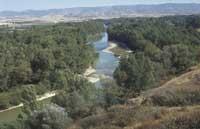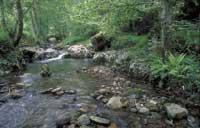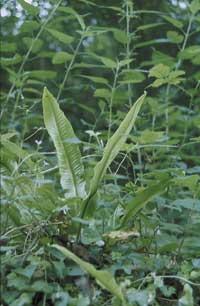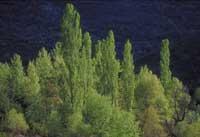Wetlands of the Basque Country (X): riverside forests and riverside forests (I)
Riparian forests and riparian forests are humid forest ecosystems created by periodic floods and their contributions to margins and land. Its main feature is wet and deep soils.

Riverside forests are alluvial areas known as gallery forests, river forests or riverside forests, which originate not only in mountain slabs but also on the banks of rivers and streams. However, depending on the size of the river and its biogeographical and geomorphological characteristics, the extent and plant composition of the riparian forests varies. In the case of Euskal Herria, the most complex and rich alluvial media are found in the Aturri River and in the rivers of the Mediterranean plain, that is, in the rivers Ebro, Baia, Zadorra, Ega, Arga and Aragón, and in several of its tributaries. In all of them, due to the softness of the relief, large meanders are formed in which humid and rich ecosystems develop, known as riverside forests.
These forest wetlands, created as a consequence of the dynamics of rivers, besides being a true refuge of biodiversity, are for many reasons of great importance for the ecological balance of them:
- Primary production is very high.
- They regulate the exchange of food between land and water and facilitate the purification of wastewater.
- Its shade prevents eutrophication of water.
- They are effective natural defenses in case of flooding.
- They facilitate the sedimentation of food dissolved in water.
- They maintain the fertile lands of the valleys.
- The diversity of biotopes in riverside forests makes the richness of life very high.
- They are places of great scenic and aesthetic value and constitute an important element of landscape diversification in the arid south of the Basque Country.
Riverside forests are directly related to meanders resulting from river dynamics. The rivers excavate the outer shores of the meanders and form sandy and gravel beaches on the inner edge. When vegetation colonizes these beans, riverside forests are created.
The rich life of the riverside forests can be defined as the result of its abundant geomorphological structure. These geomorphological structures include the following:
Alluvial deposits of sand or gravel. These deposits, also known as point-bar, are formed on the convex side of the meander.
Secondary channels. These small inlets at the top of the meander traverse the riverside forest and only lead the water in flood times.
Maternal channels. They are narrow and long depressions that usually appear near the main channel. These structures, which normally have a layer of water throughout the year, are formed by closing with alluvial accumulation access to secondary channels or by producing an alluvial deposit that isolates a mass of water in the main channel. Often, the maternal channels converge in the lower part of the riverside forest with the main channel, where there is an exchange between the stagnant waters of the maternal channel and the stream of the river. Maternal channels are areas of great biological dynamism.
River banks. can be abrupt or beach shaped.
Erosive escarpments. Currents are structures resulting from erosion in the Quaternary river grounds and in the plaster layers on the edge of the alluvial plain.
Rocky outcrops. When the river erodes the entirety of the Quaternary alluvial depot, muddy calcareous layers often emerge. In the areas where these outcrops appear, the speed of water is accelerated and living water zones are formed.
Vegetation

As for the vegetation that develops on the banks of the rivers, due to its constant rejuvenation due to the dynamics of the river, it consists mainly of gallery forests formed by colonizing species. These galleries forests, outside the current, are structured in vegetation belts. This structure depends on factors such as the level of the water table, the influence of floods, granulometry and composition of the substrate, without forgetting the human influence. In the case of Euskal Herria, the biogeographic factor must also be taken into account, since the passage of the border between the Euro-Siberian and the Mediterranean region through the center of our territory causes different forests of galleries to develop north and south of this boundary.
In general, gallery forests usually have three vegetation belts:
Vegetation of stagnant waters that remain out of the current.
Vegetation that develops on pebble and gravel beaches, often flooded by floods.
Rare riverside vegetation in the subsoil.
Although the presence of these three large vegetation belts is characteristic of all gallery forests, due to the aforementioned biogeographic factor, in each of them the composition of vegetation is different in the rivers of the Euro-Siberian and Mediterranean region.
On the shores of the Euro-Siberian region, conditioned by the humid oceanic climate, the alder is the most abundant tree, so, although there are other tree species, these forests are known as alisedas.
However, as mentioned above, a more comprehensive study allows differentiating different plant communities in these gallery forests. In the narrow beaches of gravel and pebbles that form in the meanders of these short and abrupt rivers a belt of vegetation formed by several species of willows and mimbres is formed. The plant species that inhabit these communities, known as Sahasti, face very demanding conditions, since in addition to periodic floods, the strength of the floods produces an abrasive mechanical effect and the erosion of the scarce land that can accumulate on gravel and pebbles. Among the species that have adapted to live in these extreme conditions, the red wicker is the most abundant, but usually accompanied by some dark willow or white wicker.
Further back, only on the banks of the rivers that are flooded in large seasonal avenues, the aforementioned aliseda is formed. Aliseda is a shady and humble forest that forms in humid and turbulent soils. Although the predominant tree in these forests is the alder, as its name suggests, it is also the residence of other trees and shrubs such as ash, hazel, zumalakarra or dark willow. The understory of the alisedas is also very rich, among the species that inhabit it, the ferns Phyllitis scolopendrum and Osmunda regalis and the lamottiana Myosotis, Hypericum androsaemum, Arum italicum, Saxifraga hirsuta, Carex remote, Carex penrobusta, Festuca giant or, or Belemella.

However, as we approach the Mediterranean region, the vegetal composition of the alisedas varies and, in addition to those already mentioned, appear the common maple, the black poplar, the puff pastry of elms, the white spikes of the north and the south or the black willow. The herbaceous composition of the understory is also modified.
Finally, in the areas of expansion of the valleys, after the alisedas, a belt of vegetation known as ash is formed in the deep, humid and fertile soils of the valleys. These polyphyte forests, which are barely affected by flooding, in addition to ash, are formed by white and common maples, leafy linden, leafy elms and pedunculated oaks. Due to soil fertility, these forests are rich in shrubs, bushes and herbs, so the undergrowth of strawberries is closed and compact. Among the bushes and bushes stand out the black and white hawthorn, the golden, the bush, the mulberry and the cord. In the undergrowth, however, the fern of Polysticarto setiferum and the herbs of Arum italicum, Veronica montana, Glechoma hederacea or Hypericum androsaemum are the most abundant.
However, as mentioned above, the most complex and rich plant formations on the banks are concentrated on the banks of the vast rivers of the plain that run through the Mediterranean region of the Basque Country. In a region of arid and hot summers, the gallery or riverbank forests that rivers have preserved to date are authentic humid islands surrounded by dry landscapes, where biodiversity and biomass are important compared to that of the surrounding lands.

As for vegetation, four vegetation belts can be distinguished in well-preserved riverside forests. The first is formed in beaches of pebbles, sands or silts that periodically flood the avenues and is formed mainly by species of willows and mimbres, so it is known as sauceda. In these Mediterranean willows affected by floods, the main species are the fragile wicker, the red wicker, the leafy wicker and the Salix triandra.
After the saucedes, only in areas flooded by large avenues, you can see choperas dominated by species of white and black poplar. The choperas are closed and humid forests in which, in addition to the mentioned trees, large willows abound like the Salix neotricha, puff pastry of strawberries, puff pastry of elms or black alder. In the understory, herbaceous species such as Rubia tinctorum, Brachypodium sylvaticum, Agrostis stolonifera, Humulus lupulus… Shrubs and bushes such as the Rubus ulmifolius, the black hawthorn, the white hawthorn of the north, the fleas arcas…
Often inside the choperas there are stagnant and superficial water wells (mother canals, bays…). They form compact reeds composed mainly of Phragmites australis, Typha angustifolia, Typha dominguensis, Typha latifolia and Scirpus lacustris heliophyte.
Behind the choperas, although rarely sunk in the floods, in extensive valleys that maintain a high soil moisture, are forests known as the elms because they are the main tree species the puff pastry of elms. In it coexist, along with Zumarraga, small leaves of ash, black hawthorn, white hawthorn from the north and several brambles and coffers. Also noteworthy are the presence of wild vine and the abundance of climbing plant species. However, among the herbs are Arum italicum, Brachypodium sylvaticum, Ranunculus sylvaticum, Ranunculus ficaria and Iris foetidisima.
Finally, in the area furthest from the water is the type of forest known as miracles, because it consists mainly of several species of thousands. This belt of vegetation does not withstand the usual water fluctuations in the valleys, so the vegetation that develops in it is less dependent on water than in the rest of the belts. In addition, it can admit a certain degree of salinity, since when the water table drops and the soil dries, the salts dissolved in the water are concentrated. In soils that present these characteristics (temporary hydromorphism, a certain degree of salinity and a suffocating character), most of the time the French millennium lives shrub, but it is easy to see the African millennium and the thousand canary in areas of greater salinity. The species Elymus repens, Phragmites australis or Glyzyrhiza glabra are also typical of these miracles.
Buletina
Bidali zure helbide elektronikoa eta jaso asteroko buletina zure sarrera-ontzian











